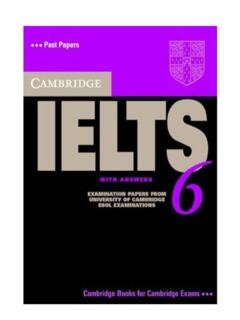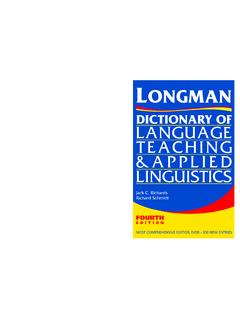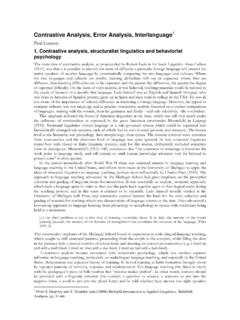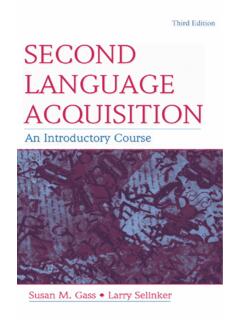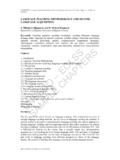Transcription of How Languages are Learned - SAINT DAVID
1 Fourth Edition How Languages are Learned OXFORD ACKNOWLEDGEMENT S. U N I V E R S I T Y PRESS The authors and publisher are to those who have given permission to reproduce thefo!lowing extracts and Great Clarendon Street, Oxford, ox2 6DP, adaptations of copyright material: Extract from United Kingdom language Development and language Disorders by lois Oxford University Press is a department of the Bloom and Margaret lahey (1978). Macmillan University of xford. It furthers the University's Publishers; Figure from 'Sorne issues relating objective of excellence inresearch, scholarship, to the Monitor Model' by Stephen Krashen, On and education by publishing worldwide. Oxford TESOL(1977). Reprinted by permission of TESOl is a registered trade mark of Oxford University International Association; Extract from Press in the UKand in certain other countries 'Constructing an acquisition-based procedure Oxford University Press 2013.
2 For second language assessment' by Manfred Pienemann, MalcolmJohnston, and Geoff Brindley The moral rights of the author have been asserted inStudies in SecondLanguage Acquisttion, Volume 10/2, First published in 2013 (1988). Reproduced by permission of 2017 2016 2015 2014 2013 Cambridge University Press; Extract from 10 9 8 7 6 5 4 3 2 1 'Speeding up acquisition of hisfher: Explicit L1/L2. Al! rights reserved. No part of this publication contracts help' in Second language Acquisttion and may be reproduced, stored in a retrieval system, the Younger Leamer: Child's Play? by Joanna White or transmitted, in any form or by any means, (2008) With kind permission ofJohn without the prior permission in writing of Oxford Benjamins Publishing Company, Amsterdam/.
3 University Press, or as expressly permitted by law, Philadelphia; Extract from 'Second language by licence or under terms agreed with the instruction does make a difference' by Catherine appropriate reprographics rights organization. Doughty in Studies in Second language Acquisition, Enquiries concerning reproduction outside the Volume 13/4, (1991). Reproduced by scope of the above should be sent to the ELT permission of Cambridge University Press; Rights Department, Oxford University Press, Reprinted from Intemationa!Jouma! of Educational at the address above Research, Volume 37 by Merrill Swain and Sharon Lapkin 'Talking it through: two French immersion You must not circulate this work in any other learners' response to reformulations' form and you must impose this samecondition (2002) with permission from Elsevier; Extract on any acquirer from 'Corrective feedback and learner uptake'.
4 Links to third party websites are provided by by Roy lyster and Leila Rauta in Studies in Second Oxford in good faith and for information only. language Acquisition, Volume 19/1 (1997). Oxford disclaims any responsibility for the Reproduced by permission o Cambridge materials contained in any third partywebsite University Press. referenced in this work Cartoons by: Sophie Grillet Oxford University Photocopying Press 1993, 2005, and 2012. The Publisher grants permission for the photocopying of those pages marked 'photocopiable' according to the following conditions. Individual purchasers may make copies for their own use or for use by classes that they teach. School purchasers may make copies for use by staff and students, but this permission does not extend to additional schools or branches Under no circumstances may any part of this book be photocopied for resale I S BN : 978 O 19 454126 8.
5 Printed in China This book is printed on paper from certified and well-managed sources. L. To the teachers and students from whom we have Learned so much 1. t CONTENTS. Acknowledgements x1. Preface to the fourth edition xiii lntroduction 1. Before we begin.. 2. 1 language learning in early childhood 5. Preview 5. First language acquisition 5. The first three years: Milestones and developmental sequences 6. The pre-school years 12. The school years 13. Explaining first language acquisition 14. The behaviourist perspective 15. The innatist perspective 20. lnteractionist/developmental perspectives 24. language disorders and delays 29. Childhood bilingualism 30. Summary 33. Suggestions for further reading 34.
6 2 Second language learning 35. Preview 35. Learner characteristics 36. Learning conditions 38. Studying the language of second language learners 40. Contrastive analysis, error analysis, and interlanguage 41. Developmental sequences 45. More about first language influence 57. Vocabulary 60. Pragmatics 65. Phonology 68. Sampling learners' language 72. Summary 72. Suggestions for further reading 73. viii Contents 3 Individual differences in second language learning 75. Preview 75. Research on learner characteristics 77. Intelligence 79. language learning aptitude 80. Learning styles 83. Personality 84. Attitudes and motivation 87. Motivation in the classroom 88. Identity and ethnic group affiliation 89.
7 Learner beliefs 90. Individual differences and classroom instruction 92. Age and second language learning 92. The critica! period: More than just pronunciation? 94. Intuitions of grammaticality 95. Rate oflearning 96. Age and second language instruction 96. Summary 99. Suggestions for further reading 100. 4 Explaining second language learning 103. Preview 103. The behaviourist perspective 103. Second language applications: Mimicry and memorization 103. The innatist perspective 104. Second language applications: Krashen's 'Monitor Model' 106. The cognitive perspective 108. Information processing 108. Usage-based learning 110. The competition model 111. language and the brain 113. Second language applications: Interacting, noticing, processing, and practising 113.
8 The sociocultural perspective 118. Second language applications: Learning by talking 119. Summary 120. Suggestions for further reading 121. Contents lX. 5 Observing learning and teaching in the second language classroom 123. Preview 123. Natural and instructional settings 123. In natural acquisition settings 124. In structure-based instructional settings 126. In communicative instructional settings 127. Observation schemes 129. Classroom comparisons: Teacher-student interactions 129. Classroom comparisons: Student-student interactions 135. Corrective feedback in the dassroom 139. Q uestions in the dassroom 145. Ethnography 149. Summary 151. Suggestions far further reading 152. 6 Second language learning in the classroom 153.
9 Preview 153. Proposals far teaching 153. 1 Get it right from the beginning 154. 2 Just listen .. and read 159. 3 Let's talk 165. 4 Get two far one 171. 5 Teach what is teachable 177. 6 Get it right in the end 182. Assessing the proposals 194. Summary 197. Suggestions far further reading 198. 7 Popular ideas about language learning revisited 201. Preview 201. Reflecting on the popular ideas: Learning from research 201. Conclusion 212. Glossary 213. Bibliography 227. lndex 249. PREFACE TO THE. FOURTH EDITION. How Languages Are Learned (HLAL) started out as a series of professional development workshops for teachers in Quebec, Canada, where we both worked for many years. Three editions of the book have now travelled far from those origins.
10 When we were working on the first edition in the 1980s and 1990s we were still in the early days of remarkable growth of research in second language acquisition. In updating the research for each new edition, the decisions about what to include have grown more diflicult. Keeping the book to a reasonable length has often meant choosing between classics in the field and important new studies, of which there are now so many. In this edition, we have annotated sorne 'Suggestions for further reading' at the end of each chapter. We encourage readers to follow these readings and the refer ence list to deepen their understanding of topics that we can only introduce here. In this fourth edition of HLAL, we have added 'Questions for reflection' at the end of each chapter, and we have included sorne new 'Activities' that give readers opportunities to explore sorne of the topics.
